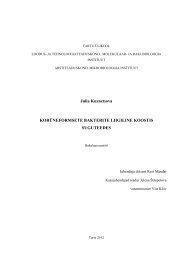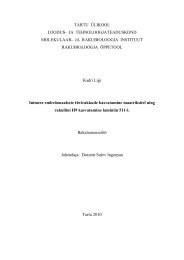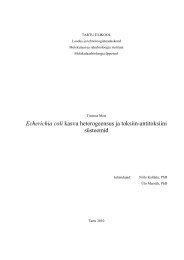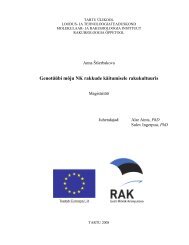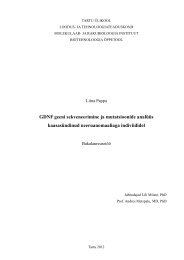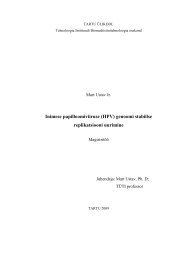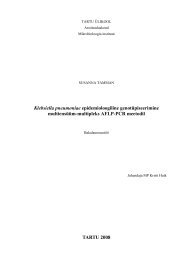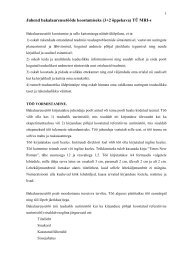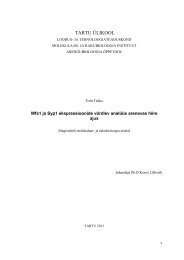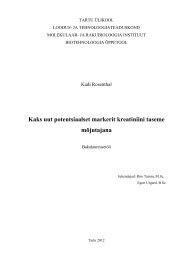Maternal variation in Huichol and Mixtec populations from Mexico
Maternal variation in Huichol and Mixtec populations from Mexico
Maternal variation in Huichol and Mixtec populations from Mexico
You also want an ePaper? Increase the reach of your titles
YUMPU automatically turns print PDFs into web optimized ePapers that Google loves.
2.3 RESULTS AND DISCUSSION<br />
2.3.1 Phylogenetic network<br />
All <strong>Mixtec</strong> <strong>and</strong> <strong>Huichol</strong> samples belong to American founder haplogroups A2, B2, C1 <strong>and</strong><br />
D1, with the exception of one <strong>Huichol</strong> belong<strong>in</strong>g to m<strong>in</strong>or haplogroup C4c.<br />
The Southwest, Mesoamerica <strong>and</strong> Central America haplogroups frequencies <strong>in</strong> different<br />
<strong>populations</strong> are shown <strong>in</strong> Figure 4. In the Mesoamerica dom<strong>in</strong>ates haplogroup A, while <strong>in</strong> the<br />
Central America <strong>and</strong> <strong>in</strong> the Southwest the haplogroup A is less exposed, or even almost<br />
absent like <strong>in</strong> the Southwestern USA (e.g. Zuni, Akimel O´odham, Jemez, Hualapai<br />
<strong>populations</strong>). In several Mexican <strong>populations</strong> there has also not been found haplogroup A<br />
(Cochimi, Delta Yuman, River Yuman <strong>populations</strong>), but they a considered closer to<br />
Southwest. The haplogroup B is more frequent <strong>in</strong> the Southwest <strong>and</strong> Central America, than <strong>in</strong><br />
Mesoamerica. The haplogroup C frequency is relatively low <strong>in</strong> comparison with A <strong>and</strong> B<br />
haplogroups, but is mostly exhibit <strong>in</strong> the Southwest <strong>and</strong> Cental America. The D haplogroup is<br />
with the smallest frequency, but is found <strong>in</strong> small amount <strong>in</strong> some Mesoamerica, Southwest,<br />
<strong>and</strong> <strong>in</strong> one Central America population. Haplogroup X is found only <strong>in</strong> Jemez <strong>and</strong> Navajo<br />
<strong>populations</strong> <strong>from</strong> the Southwestern USA with really small frequency. The rare haplogroup<br />
D4h3 is detected <strong>in</strong> one Tarahumara population <strong>from</strong> the North <strong>Mexico</strong>.<br />
Present study of <strong>Mixtec</strong> <strong>and</strong> <strong>Huichol</strong> <strong>populations</strong> revealed results close to the published one.<br />
The <strong>Mixtec</strong>s mostly exhibit haplogroup A (62%), which is a little different <strong>from</strong> the<br />
previously published data (72%) (Kemp et al., 2010; Torroni et al., 1994; S<strong>and</strong>oval et al.,<br />
2009). Haplogroup B frequency is similar between published <strong>and</strong> present study (17%),<br />
haplogroup C frequencies vary <strong>from</strong> 14% (present study) to 7% (published) (Kemp et al.,<br />
2010; Torroni et al., 1994; S<strong>and</strong>oval et al., 2009). The haplogroup D frequencies are low: 7%<br />
<strong>and</strong> 3% accord<strong>in</strong>gly. A little variety among both data is probably due to the small number of<br />
samples studied. The haplogroup X was not found <strong>in</strong> <strong>Mixtec</strong> population.<br />
The <strong>Huichol</strong> mostly exhibit haplogroup B (47%), which is close to previously studied <strong>Huichol</strong><br />
haplogroup B frequency (53%). The population exhibits less haplogroup A (33% <strong>and</strong> 31%<br />
<strong>from</strong> both data). The haplogroup C frequency is only 16% <strong>and</strong> 20% accord<strong>in</strong>gly. The<br />
haplogroup D <strong>and</strong> haplogroup X are absent <strong>in</strong> <strong>Huichol</strong> population.<br />
21



